最新トピックス
最近の論文紹介 (page.3) (2012年~2015年)
"Study of self-consistent particle flows
in a plasma blob with particle-in-cell simulations"
H. Hasegawa and S. Ishiguro,
Physics of Plasmas Vol.22, 102113 (2015)
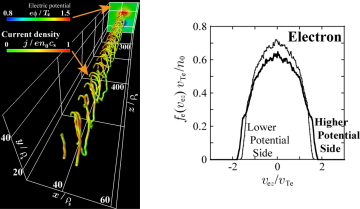
In this study, the presence of the spiral current system composed of the diamagnetic and parallel currents in a blob is confirmed by the particle simulation without any assumed sheath boundary models (see the left figure). Furthermore, we have observed that the temperature structure in a blob is formed by the potential structure (see the electron velocity distributions in the right figure) |
"Molecular dynamics and Monte Carlo hybrid simulation for fuzzy tungsten
nanostructure formation"
A.M. Ito, A. Takayama, Y. Oda, T. Tamura, R. Kobayashi, T. Hattori, S.
Ogata, N. Ohno, S. Kajita, M. Yajima, Y. Noiri, Y. Yoshimoto, S. Saito,
S. Takamura, T. Murashima, M. Miyamoto and H. Nakamura,
Nuclear Fusion Vol.55, 073013 (2015)

Fuzzy nanostructure on the surface of tungsten materials is generated by
exposure to helium plasma. The formation process of the fuzzy nanostructure
had been successfully reproduced by Molecular Dynamics and Monte-Carlo
hybrid (MD-MC hybrid) simulation. |
"Effects of trapped electrons on ion reflection in an oblique shock
wave"
M. Toida and J. Inagaki,
Physics of Plasmas Vol.22, 062305 (2015)
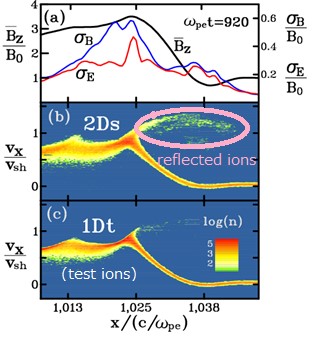
A magnetosonic shock wave propagating obliquely to the magnetic field can
trap electrons and accelerate them to ultrarelativistic energies. These
electrons excite multi- dimensional fluctuations, which significantly influence
electron motions.
Effects of trapped electrons on ion motions in an oblique shock wave have
been investigated with particle simulations. It is found that the number
of accelerated ions via reflection from the shock front is increased because
of the multi-dimensional fluctuations excited by the trapped electrons.
The figure shows the phase space plots of ions [(b) 2Ds] and test ions
[(c) 1Dt] which do not feel multi-dimensional fluctuations. The ions with
vx > vsh are reflected. |
"Formation of large-scale structures with sharp density gradient through
Rayleigh-Taylor growth in a two-dimensional slab under the two-fluid and
finite Larmor radius effects"
R. Goto, H. Miura, A. Ito, M. Sato, and T. Hatori,
Physics of Plasmas Vol.22, 032115 (2015)
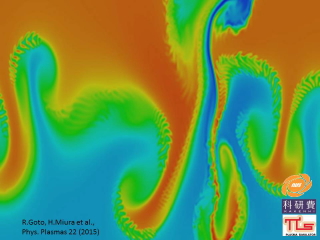
Density contours in a 2D extended MHD simulation of the Rayleigh-Taylor
instability. It is observed that the secondary Kelvin-Helmholtz-type instability
forms fine wavy structures along the density contours. |
"Multi-Hierarchy Simulation of Collisionless Driven Reconnection by
Real-Space Decomposition"
S. Usami, R. Horiuchi, H. Ohtani, and M. Den,
Journal of Physics: Conference Series Vol.561, 012021 (2014)
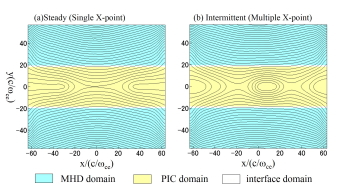
Spatial profiles of the magnetic field lines. By means of our multi-hierarchy simulations, the influence of macroscopic dynamics on microscopic physics of magnetic reconnection is investigated. Dynamical behaviours of reconnection that is, steay reconnection (Fig.(a)) or intermittent reconnection (Fig. (b)) depend sensitively on plasma inflows from the MHD domain. |
"Structure transitions induced by the Hall term in homogeneous and
isotropic
magnetohydrodynamic turbulence"
H. Miura and K. Araki,
Physics of Plasmas Vol.21, 072313 (2014)
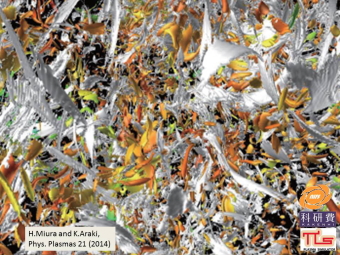
Isosurfaces of the enstrophy density (colored) and the current density
(grey) in freely decaying homogeneous and isotropic Hall MHD turbulence
in a simulation of 10243 grid points. |
"Suppression effects of Weibel instability for fast electron divergence"
H. Sakagami, T. Johzaki, T. Taguchi and K. Mima,
EPJ Web of Conference Vol.59, 17016 (2013)
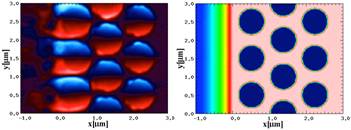
As the growth rate of the Weibel instability is absolutely large, little suppression effects can be expected even if the background electron temperature increase to more than 100 keV. This magnetic field does not remain at rest and shows turbulent behaviors, enhancing the divergence of fast electrons. To control the location of Bz, punched out targets are introduced, where many vacuum holes are punched out as shown in left Figure. Background electrons that carry the return current can only flow in the gaps between holes, because the sheath field prevents them from crossing over the hole. Thus stable magnetic fields are induced and grow up to almost ±300 MG, which are shown in right figure. Fast electrons go forward with a meandering motion, and reduction of divergence can be expected. Unfortunately, this structure simultaneously disturbs fast electron propagation, and the fast electron beam intensity also decreases because the number of electrons in such energy range is reduced. |
"Development of Multi-Hierarchy Simulation Model with Non-Uniform
Space Grids for Collisionless Driven Reconnection"
S. Usami, R. Horiuchi, H. Ohtani, and M. Den,
Physics of Plasmas Vol.20, 061208 (2013)
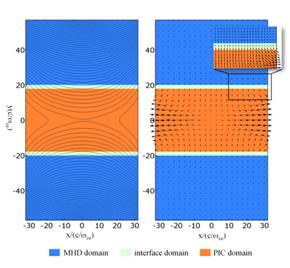
Multi-hierarchy simulation result of magnetic reconnection. The left and
right panels display magnetic field lines and fluid velocity vectors. The
multi-hierarchy model is progressed from the previous model as follows.
First, the boundary condition in the downstream is improved from periodic
to open, thus outflow can go out across the downstream boundary. Furthermore,
non-uniform space grids are adopted in the macro hierarchy so as to calculate
larger region. |
"Analytic Equilibria of High-Beta Tokamaks with Toroidal and Poloidal
Flows and Pressure Anisotropy Associated with Parallel Heat Flux"
A. Ito and N. Nakajima,
Journal of the Physical Society of Japan Vol.82, 064502 (2013)
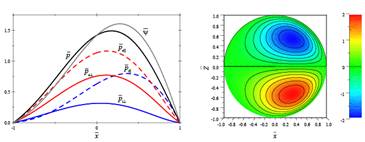
Profiles of pressures and the magnetic flux in the midplane (left) and the radial component of the diamagnetic current in a poloidal cross section (right) obtained from the analytic solution for tokamak equilibria with flow and pressure anisotropy. |
"Formation and Classification of Amorphous Carbon by Molecular Dynamics
Simulation"
A. M. Ito, A. Takayama, S. Saito, and H. Nakamura,
Japanese Journal of Applied Physics Vol.52, 01AL04 (2013)
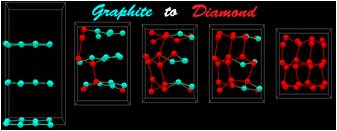
(Color online) Animation snapshots in the MD simulation for transition
from graphite to diamond at a pressure of 15 GPa. The green and red spheres
indicate sp2 and sp3 carbon atoms, respectively. The white lines show the side of the simulation box under the periodic boundary condition. |
"Kinetic effects on robustness of electron magnetohydrodynamic structures"
M. Hata, H. Sakagami, and A. Das,
Physics of Plasmas Vol.20, 042303 (2013)
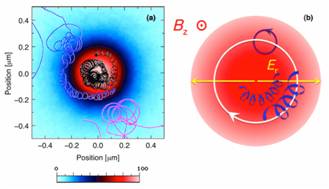
(a) Electron orbit in the case of R=8 at the temperature of 4 keV, where
black, blue, and pink lines indicate orbits and color contour represents
magnetic field in the z direction.
(b) Schematic for sustained mechanism of electron's orbit, where red shading
and yellow arrows express magnetic field in the z direction and radial
electric field, and purple and white circles and blue-drifted-circle represent
Larmor motion, circular motion via ExB drift, and electron orbit that results
from Larmor motion and ExB drift, respectively.
|
"Macro- and microphysics of magnetic reconnection in a multi-hierarchy
open system"
R. Horiuchi, M. Den, T. Tanaka, H. Ohtani, and S. Usami,
Plasma Physics and Controlled Fusion Vol.55, 014008 (2013)
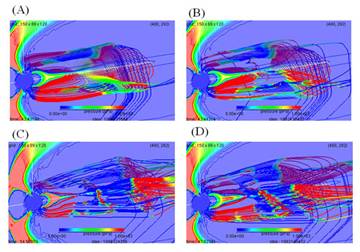
Global MHD simulation of geomagnetosphere reconnection with kinetic resistivity. Spatial profiles of magnetic field lines and pressure are plotted when reconnection sets in (top panels) and when flux rope is formed (bottom panels). The left and right panels stand for the results for an effective resistivity model based on steady collisionless driven reconnection, and those for a constant resistivity model. Color on the lines presents the Bz intensity. |
"Visualization of Particle Trajectories in Time-Varying Electromagnetic
Fields by CAVE-Type Virtual Reality System"
N. Ohno, H. Ohtani, D. Matsuoka, R. Horiuchi,
Plasma and Fusion Research Vol.7, 1401001 (2012)

CAVE visualization of the time-varying data at (1) T=0, (2) 25 T, and (3)
50ΔT, where ΔT is time interval of storing the simulation data. The color
contours on xy and yz planes are ion temperature and a reconnection component
of magnetic field, respectively. The blue and white lines are magnetic
field and ion trajectories, respectively. The magnetic field lines are
drawn by the data at the each time, while the ion trajectories are shown
as time-tracing lines from T=0. |
"Effects of long rarefied plasma on fast electron generation for FIREX-I targets"
H. Sakagami, A. Sunahara, T. Johzaki, and H. Nagatomo,
Laser and Particle Beams Vol.30, 103-109 (2012)
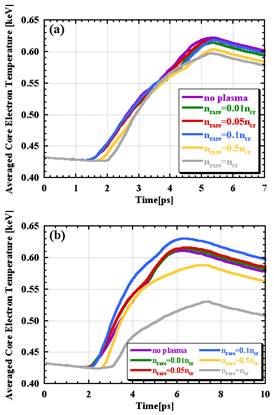
These figures show time evolutions of averaged core electron temperature
over the dense region (ρ>10 g/cm3) without rarefied plasmas(purple)
and with rarefied plasmas of different densities, 0.01(green), 0.05(red),
0.1(blue), 0.5(yellow) and 1(gray) critical density for (a) Lrare=150 and
(b) 300 μm. |
"Simulation of Plasma Flow Injection with Multi-Hierarchy Model Aiming Magnetic Reconnection Studies"
S. Usami, H. Ohtani, R. Horiuchi, and M. Den,
Communications in Computational Physics Vol.11, 1006-1021 (2012)
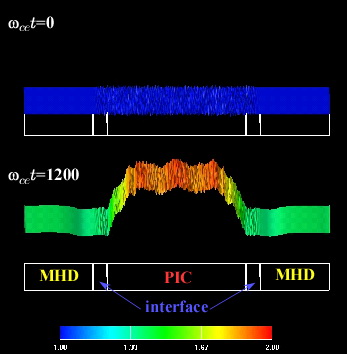
Bird's eye view of the mass density in the multi-hierarhcy simulation. At the initial state, mass density is uniform. Plasmas smoothly and continuously flow from the MHD to PIC domains through the interface domain. |
|
|
|
 研究所WEBへ
研究所WEBへ 研究所WEBへ
研究所WEBへ